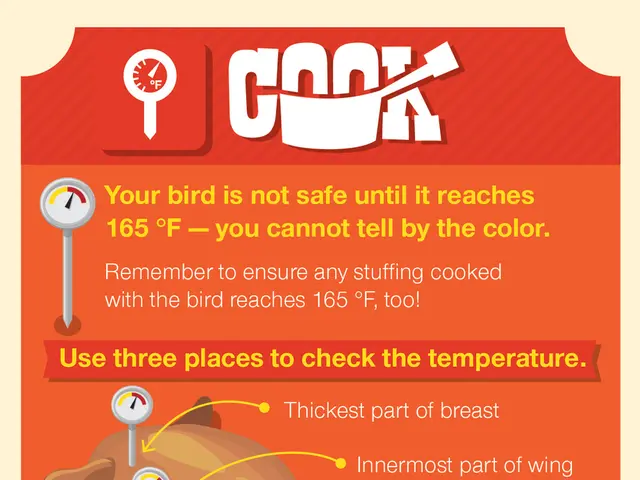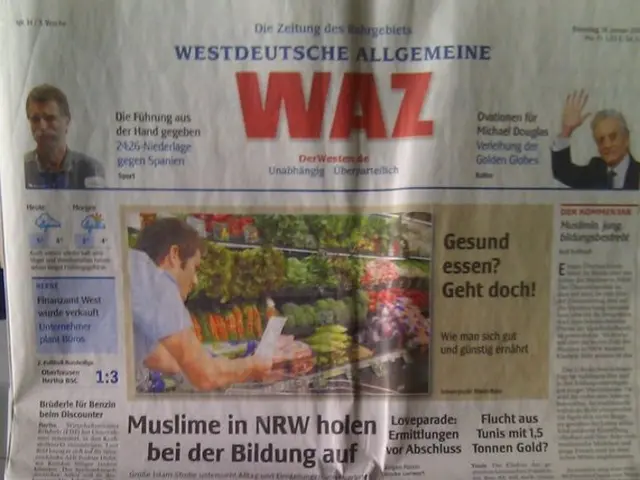Shoppers paying for food supplies: Insight into current economic conditions
Going Grocery Shopping the New-Age Way
In today's economy, "buy now, pay later" (BNPL) loans are no longer limited to big-ticket items like vacations and electronics. Now, they're being used for everyday necessities, like groceries.
Tia Hodge, a resident of Austell, Georgia, recently used the BNPL service offered by Klarna to purchase groceries from her local Kroger. With her bill totaling nearly $400, she split the payment into four installments of around $100, all interest-free.
"Food prices are skyrocketing," said Hodge, who plans her grocery spending based on her month's cash flow and other expenses like credit card debt and student loans. By using BNPL, Hodge and her family of four, soon to be five, can budget more effectively.
Over a quarter of Americans are now using BNPL loans for groceries, according to a recent survey by LendingTree. This figure has increased from 14% just a year ago. It's not just groceries–Americans are also using BNPL for recurring monthly bills, including internet, electricity, and streaming services.
Consumers can now split gasoline expenses, fast-food orders, or even rent payments into manageable installments. Social media is buzzing with tips on utilizing short-term financing for everyday expenses.
While some consumers find BNPL helpful for managing their cash flow, others see this trend as a worrying sign of growing financial stress among Americans.
According to Matt Schulz, chief consumer finance analyst at LendingTree, "It's at least a sign of how much people are struggling." Overextending oneself with multiple BNPL loans can lead to financial trouble, he warns.
However, others, like Christopher Uriarte, a payments expert at Glenbrook Partners, believe BNPL for day-to-day expenses is a part of the industry's growth and a better option than traditional credit cards.
In 2019, consumers in the United States used BNPL loans for about $2 billion worth of goods and services. By 2023, that amount soared to over $116.3 billion, according to CapitalOne Shopping Research. Although this total is still a fraction of the $1.18 trillion spent using credit cards in 2025, as per data from the Federal Reserve Bank of New York, the ease and availability of BNPL loans might encourage younger and low-income Americans to take on more debt than they should, warn consumer groups.
Many BNPL loans are not routinely reported to credit bureaus or captured in public data, posing a potential hidden risk to the financial system that experts sometimes refer to as "phantom debt."
Randis Dennies, a retail operations supervisor from Memphis, Tennessee, has used BNPL loans for groceries and paying bills, finding it beneficial for managing his cash flow and borrowing with zero interest. According to a spokesperson from Affirm, a leading BNPL provider, the company is using its experience in underwriting higher-cost purchases to underwrite "everyday purchases."
The continuous increase in food prices–now 28% higher than in 2020– is particularly tough on low-income households, spending around a third of their after-tax income on food in 2023, compared to 13.5% for middle-income households.
Lower-income households, earning less than $50,000 a year, are also the heaviest users of BNPL, according to the latest survey of U.S. households by the Federal Reserve. Inflation in food prices and other everyday expenses has led individuals to take on debt or dip into their savings.
However, the use of BNPL loans is not without risks. According to a survey, nearly a quarter of all BNPL users made a late payment last year–a significant increase from 2023. Overspending and financial vulnerability can lead to a cycle of debt ifusers are not careful.
Klarna, one of the fastest-growing BNPL providers in the United States, reported a 17% year-over-year increase in credit losses in the latest quarter. Despite this, the company's default rate has remained stable and represents a tiny share of their total loans.
In light of these findings, the Consumer Financial Protection Bureau has expressed concerns about the financial vulnerability of BNPL customers, especially during economic downturns. Despite this, the agency announced earlier this year that it would not prioritize enforcement actions on BNPL loans.
Despite the risks, Tia Hodge continues to use BNPL services carefully, tracking her spending and ensuring timely payments. Stores and service providers are eager to offer these payment options, even at a cost, since customers are more likely to complete purchases and buy more items when BNPL is available.
- Tia Hodge, a resident of Seattle, utilized the BNPL service offered by Klarna not just for groceries but also for personal-finance matters like her utility bills and student loans.
- The lifestyle of many Americans seems to revolve around food-and-drink, with a recent survey suggesting that 35% of Seattle residents use BNPL loans for ordering food and beverages from local cafes and restaurants.
- As technology advances, it's not surprising that gadgets like smartphones have become essential items mainstreamed by the Seattle community. The latest LendingTree survey shows that 20% of Seattle residents use BNPL loans for buying new smartphones or replacing their existing ones.
- With the rise in technology, shopping in Seattle has taken a more efficient turn, as BNPL services are now being used for online purchases of various products such as furniture, clothing, and technology gadgets.
- General-news outlets in Seattle are abuzz with stories about the economy and finance, discussing the financial implications of using BNPL for everyday purchases and whether this trend is indicative of growing financial stress among residents.
- Despite the convenience of using BNPL for everyday expenses, experts warn that overextending one's finances by accumulating multiple BNPL loans can lead to financial trouble. As such, it's essential to practice responsible budgeting and maintain timely payments when considering this option.








